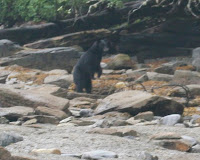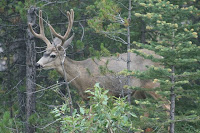Between arriving back from the Rockies and leaving for the Vancouver Island adventure, we continued visiting attractions such as the Capilano Suspension Bridge (after which we went and had coffee with Ann and Jean-Pierre, a lovely couple we met on the ship who live nearby), the Museum of Anthropology (what a magnificent place, so thanks for the tip Andy and Kim ) in which we saw the magnificent Bill Reid cedar sculpture below, the beautiful totem poles in Stanley Park and Grantville Island (again!).
Kippers has organised great weather for us and our sight-seeing has barely been disrupted by rain, hail or pestilence and he has very generously ferried us all over Vancouver. Also met up with the Vancouver Heather Goddard, who Glenn Pyman had inadvertantly 'met' by attempting to send me an email which was wrongly addressed - how amazing!
The afore-mentioned and ever-reliable Kippers delivered us to the bus station at 6.15 the Sunday morning beforelast so we could catch the bus to Tsawassen and the BC Ferry to Swartz Bay and then Victoria on Vancouver Island. The ferry ride was very picturesque, as half of the route is through the Gulf Islands and it was a fine, but chilly, morning. Once we were deposited safely in Victoria, we picked up the hire car and had a wander through the Inner Harbour and checked out the beautiful Legislative Buildings (Victoria is the capital of British Columbia) and other lovely heritage buildings close by, before heading north.
We travelled up to Qualicum Beach, calling in to visit the charming village of Cowichan Bay with its buildings on stilts over the water's edge, Chemainus and its many murals and Nanaimo's harbour on the way up.
Arrived in Qualicum Beach in time to dump our stuff at the B and B (discovering in doing so that our lovely hostess, Karen, knows yet another Heather Goddard - an artist who comes and stays with her regularly!!). Spent some time walking on the beach, which was just lovely, although challengingly rocky for my dodgy legs! Managed to gobble some more local fish - wild salmon and halibut, for tea at the Fish Tales restaurant. Farmed Atlantic Salmon is going to be much less appealing when we get home!
The journey west started bright and early Monday morning. Travelled through Port Alberni, which sits at the tip of the 35 kilometre Alberni Inlet and then the Cathedral Grove, a rainforest of western red cedars and 800 year old Douglas Firs. The word (or words?) awe-inspiring leapt constantly into our minds as we drove along Highway 4 to Ucluelet, on the Pacific coast. Wilderness areas, sheer rock walls, magnificent lakes and rivers with the clearest water imaginable - such as the Ellis River pictured here, surrounded us. Kennedy Lake, below, was also a picture!
Tuesday was the day for visiting nearby Tofino and the Pacific Rim National Park, although the rain and subsequent cloud limited, but didn't ruin, our walking opportunities. Our first rainforest walk was hilarious - one of the tracks was closed because of 'a bear in the area' and the adjoining noticeboard featured signs warning of wolf and cougar activity in the area!!!! Luckily the advice if encountering any of these animals is not to run - I would be in serious bother if the solution was to run for my life!
From here we travelled back to the east coast of the island, spending a night at Campbell River, before driving on to Port Hardy, which is at the end of the road north. We had a fantastic two nights here, despite Murray not being able to dive, which had been one of the main reasons for going there. The B and B we stayed in, the Orange Tabby, was the best of our whole trip! How else could you rate a place where the host, James, greets you at the door as you arrive, asking if you are ready for a glass of wine and then sends Murray off to the river fishing with all necessary gear and me, the avowed non-fisherperson, with a 'glass' of wine!
Murray went on a fishing trip on Friday and came back like an excited kid! He had caught two Halibut, a couple of Coho Salmon, a Sockeye Salmon and assorted rockfish. Susan at the B and B went out for tea that night, but handed over the kitchen so we could cook some fish for our tea. We ended up having a wonderful night, sharing fish and a bottle of Oyster Bay with Susan's sister-in-law and her husband who had just retunrnd from a trek around Cape Scott, at the very tip of the island.
On Saturday we travelled a mere 45 minutes to Telegraph Cove, a tiny 'resort' (winter population of 4!) which was originally a remote telegraph community established around a small cove. We stayed in an old cabin on the boardwalk, which is built on stilts around the cove - rather lovely. Went on a whale watching trip in the afternoon to try and spot some Killer Whales (which we discovered are not whales at all - they are a type of porpoise). We did see the two males and one female of one of the family groups, although they didn't come very close. Murray was feeling very superior about the fact that when he had been out fishing the day before, one of these same males had come right up to the boat and had sprayed them with misty air and vapour. Smart alec! Again, I was glad of the efficacy of the Sea Bands, as the sea was pretty lumpy and without them I would have been feeling more than a little sea sick.
On Sunday we set off on an expedition across to Grants Bay on the west coast. On our way up to Port Hardy to head west, we were absolutely astounded to spot a Black Bear sow and her two cubs on the roadside eating clover flowers. Many tens of photos were taken of course!
We made Grants Bay after a ninety minute drive over gravel roads and logging roads. It was an absolutely beautiful beach and the rainforest through which we walked to reach it was gorgeous, with huge old trees, ferns and many, many nurse logs on which young trees were growing.
That evening we went for a fascinating four hour trip around the Port Hardy area with Larry Woodall, a local guide to whom we were introduced by our new friends at the Orange Tabby, who has been taking a variety of hiking, canoeing and bear viewing trips for the past 33 years. Sadly we only saw one bear, a young male looking for food on the foreshore, but we saw an active bear den, a beaver lodge, some cougar poo (very exciting!) and learnt so much about Black and Grizzly Beas and their habits. We also learnt things we would rather not know about the hunting of bears!!!! Hunters can shoot two bears a year in BC and they are legally able to shoot bears (or any other game animals) that are at a greater distance than 15 metres from the yellow line down the middle of the roads. Sadly, this has left a very disturbing image in our minds!
On Monday we travelled down to Nanaimo. It rained all the way, which meant that we weren't tempted to stop and do any sight-seeing as the sights were well and truly obscured! Caught the BC Ferry back to Vancouver, where Kippers and Liette kindly picked us up and off we went back to their apartment. Had a lovely meal at the Chinese restaurant where they met. Tuesday was spent enjoying the lovely weather on Granville Island (a favourite Vancouver spot, especially for our last day) and just mucking about and organising our ever-increasing luggage. Cooked the last of the Halibut for tea - what absolutely beautiful fish!
So now it is time to go home! We have had an absolutely marvellous time - met some wonderful people, seen some unbelievably beautiful places and best of all, have spent lots of special time with Kate and Derek and Kippers and Liette. The memories will last a very long time - as long as our memories last anyway!






.JPG)
.JPG)

.JPG)
.JPG)
.JPG)
.JPG)



















.JPG)
.JPG)

.JPG)
.JPG)


.JPG)











